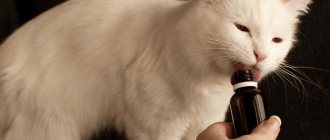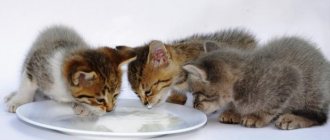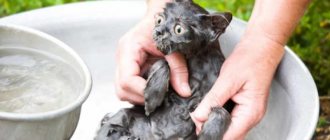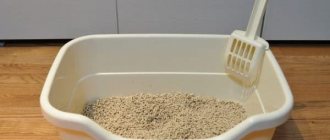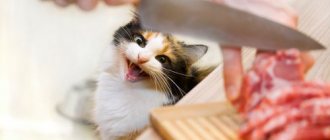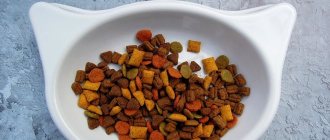Smecta is rightfully considered one of the most effective drugs that helps a person cope with diarrhea. However, for the felines he became an equally loyal friend. The main thing is to learn how to correctly calculate the dosage. Moreover, you can understand how to give Smecta to a cat by carefully reading just one article. Intestinal upset is not a rare disease for your beloved pet. There is always a reason for diarrhea. It could be something unsuitable for food, obtained on the street, or a stolen piece from the table. In any case, Smecta will be the salvation.
Compound
Smecta is available in powder form and requires dilution with water for further use. The drug is also available in the form of a suspension, ready for use, but it is more expensive.
The main active ingredient of the powder and suspension is dioctahedral smectite (diosmectite). The component is obtained from a mixture of clay minerals - aluminum and magnesium. In fact, it is edible natural clay. It is diosmectite that has the ability to absorb various substances from gases and liquids and remove them from the body.
One package contains 3 grams. diosmectite, the rest are auxiliary components:
- Dextrose monohydrate – helps replenish fluid in the body and remove harmful substances.
- Sodium saccharinate is used as a sweetener.
- Flavors. Orange or vanilla powder, caramel-cocoa suspension.
It is clear that the drug is human and flavoring is added to improve the taste. But cats may not like this supplement. Therefore, it is better to have both options (orange and vanilla) - for the pet to choose from.
Action provided
Smecta binds to the mucus of the gastrointestinal tract, envelops the intestinal walls, thereby protecting the mucous membrane from the penetration of toxins and other irritants, and also reduces inflammation.
Smectite, as the main active ingredient, has the following effects:
- prevents the penetration of viruses through the intestinal mucosa;
- absorbs gases, reduces bloating;
- normalizes the composition of microflora;
- promotes the disappearance of symptoms of intoxication and dehydration;
- relieves diarrhea.
Smecta is non-toxic and does not interfere with cat intestinal motility. The drug is excreted unchanged. Therefore, no components of the product are absorbed by the intestinal walls, do not penetrate the systemic bloodstream, and do not affect organs and systems.
What to do?
In order to normalize the act of bowel movement in a nursing cat, it is necessary to eliminate the main cause that provokes this pathological condition. To make it feel better, it is recommended to give the purr a drink of rice water. Since the cat is feeding, a starvation diet will take away even more strength and worsen its health. Therefore, instead of fasting, the pet is prescribed nutritional drips. Diarrhea can be considered cured if normal stool persists for more than 72 hours. Otherwise, liquid stool is a symptom of another disease that must be continued to be treated until the accompanying symptoms disappear completely.
Is it possible to give Smecta without a doctor's prescription?
If your cat has diarrhea for the first time and there are no other symptoms, then Smecta can be used independently.
In veterinary medicine, there are no scientific studies on contraindications for cats. The drug can be used as first aid in adult animals, pregnant and lactating animals, as well as in kittens.
When self-treating at home, it is important to monitor the cat’s condition to prevent dehydration. Alarming symptoms such as refusal of food, water, severe vomiting, fever, blood in the stool require urgent attention to a specialist.
It is important to understand that for infectious diarrhea, Smecta only eliminates the symptom – frequent, loose stools. Therefore, consultation with a veterinarian and treatment with other drugs is required to eliminate the true cause of the disease. And this could be parvovirus enteritis, panleukopenia, coronavirus.
Indications for use
For kittens and adults, the indications are the same - gastrointestinal disorders of any nature. If the reason is a change in diet or poisoning, then you can only get by with the remedy in question. If the cause is an infection, antibiotics, probiotics are used in combination with Smecta, or it is replaced with enterosorbents with a wider spectrum of action.
The drug is used in cats for diarrhea of various etiologies:
- intolerance to certain foods;
- allergies - an excess of proteins in the diet can cause such a reaction from the gastrointestinal tract + itching and hair loss;
- violation of the diet - switching from cat food to regular food and vice versa, as well as during the period of transfer of kittens from mother's milk to adult food;
- long-term treatment with antibacterial agents - if the doctor does not prescribe a probiotic for the period of antibiotic treatment, the intestinal microflora is disrupted, which is manifested primarily by diarrhea;
- infectious diseases.
"Smecta" also helps against vomiting caused by:
- infectious diseases;
- overeating;
- ingestion of fur.
If the animal is poisoned , whether to give the drug or not depends on the appearance of the vomit. If they contain food or foam, then give medicine and a large amount of liquid. This will be the first help from the owner. Then the cat must be shown to a doctor. If there are inclusions of blood in the vomit, you should immediately go to the veterinary clinic - the animal is suffering from internal bleeding.
How to prepare and give medicine to a cat
To prepare the suspension, the powder is poured with warm boiled water until it becomes liquid sour cream.
The best way to give your cat medicine in liquid form is to use a syringe without a needle. You need to prepare the solution and fill the syringe in advance so that the cat does not see - this will eliminate unnecessary anxiety for the pet.
The medicine is administered into the mouth from the side. If the cat refuses to swallow, you need to raise its head, tilt it back slightly and stroke its neck. This will cause a swallowing reflex in the animal.
The procedure for introducing medicine into the animal's mouth
To help a kitten cope with diarrhea, you will need 1 sachet of Smecta, a clean towel, boiled water and a syringe without a needle. Eliminating diarrhea with the help of this drug will help the body improve the functioning of the digestive organs without compromising health, unlike other drug analogues, which are often dangerous, releasing toxins that are absorbed into the walls of the stomach. The pharmacy sells 3-gram sachets of powder, but in order to properly give the kitten the medicine, you must adhere to the following rules:
- You can get a liquid emulsion by diluting the contents of the package with boiled water only. The mixture should have a uniform consistency. For an animal, half a sachet thoroughly mixed in 50 ml of water, the temperature of which should not exceed 40 degrees, will be enough.
- The liquid suspension should be given to cats using an ordinary 2-cc syringe. As already mentioned, a needle is not needed for this purpose. Having prepared a full syringe with Smecta and released the air, you can begin to inject the solution into the cat’s mouth.
- Before giving the suspension, the pet should be wrapped in a thick, clean cloth or towel to secure its body as much as possible. In any case, the kitten will resist, so only the head should be left unwrapped. Ensuring high-quality administration of the drug is extremely important.
- It is better to insert the syringe with the nose into a place in the mouth where there are no teeth. You don’t have to make any effort to open your pet’s mouth; you just need to slightly twist the upper lip. By gradually squeezing out the contents of the syringe, you can inject the medicine into an adult animal at one time. It is advisable for the baby to inject the drug in a couple of doses.
Side effects
With long-term use of Smecta in cats, the process of defecation may be disrupted and constipation may occur. The situation is corrected by reducing the dose.
Other possible side effects from long-term use:
- bloating, nausea, vomiting;
- impaired absorption of nutrients: vitamins, microelements.
It is also possible that individual intolerance or allergic reactions to additives in the composition may occur. Therefore, before giving Smecta in full dosage, you need to test it on a small amount of the medicine. If the animal feels well, continue treatment.
Diagnostics
If a lactating cat has diarrhea repeatedly, then the breeder needs to show the pet to a veterinarian, who will conduct an initial examination, including:
- general assessment of condition;
- measuring body temperature;
- drying heart rate and respiratory activity;
- palpation of the abdominal cavity.
Additionally, the doctor may need blood and urine test results. If the purr's condition is severe, the veterinarian will also assess the degree of dehydration. Based on the results of the diagnostic examination, treatment is prescribed and a decision is made on further continuation of lactation.
Special conditions and contraindications
Since Smecta has an enveloping effect and absorbing abilities, it can influence the speed and degree of adsorption of other drugs. The highest thickness of mucus is formed within 30 minutes after taking the drug, then it gradually decreases. Therefore, it is advisable to give any other medications to the animal at least 1 hour before taking Smecta. Otherwise, the product will bind to the sorbent and leave the body without having time to act.
You should not give Smecta to a cat if you suspect intestinal obstruction.
Natural causes of diarrhea in kittens
A newborn kitten has a sterile microflora, that is, its intestines are not populated by bacteria. When the baby begins to suck mother's milk, the intestines are populated with lactobacilli, which will help the baby digest milk, and then adult food. In the first days after birth, cat milk is very rich in lactobacilli; it is commonly called colostrum. After 2–3 days, the milk becomes more protein-rich, acquires a white color and a fatty consistency.
Usually the kitten’s digestive system copes with the first stage of adaptation without problems. Difficulties may arise if the cat does not feed the kittens and they had to be switched to milk replacers. No matter how hard biologists and scientists try, it is still impossible to recreate the structure of colostrum. It turns out that even using a special cat's milk substitute, you deal a blow to the baby's sterile digestive system. Further, everything will depend on the potential strength of the body. Statistically, only seven out of ten artificial kittens survive.
The next step in a kitten's development is the transition to adult food. Typically, kittens begin to be fed with boiled minced meat or special food at the age of 3.5–5 weeks.
It is important to understand that complementary foods should be introduced gradually, literally little by little, so that the intestinal microflora has time to react and adapt to unusual food
When food other than milk enters the kitten's intestines, the natural reaction of the mucous membranes will be irritation. A large amount of mucus will help soften and digest hard foods. It is absolutely natural that a kitten devouring minced meat will develop mild diarrhea, which will stop in less than a day and should not be repeated more than once. If everything went well, the next time you eat adult food, the microflora in the intestines will already be slightly changed.
If diarrhea starts and does not stop, you need to take action. Considering the small weight of the kitten, water loss during stool liquefaction becomes catastrophic. While an adult cat can cope with severe diarrhea for 1–2 days, a kitten becomes dehydrated within 8–10 hours.
Analogs
Enterosorbents are of several types based on their chemical structure (carbon, based on natural, synthetic resins, dietary fiber, silicon-containing). Smecta is a natural silicon-containing sorbent.
Analogues from the natural group:
- Polysorb;
- Kaolin (white clay);
- Neosmectin.
Synthetic analogues:
- Enterosgel;
- Enterodesis;
- Enterosorb.
Studies have shown that the power of Smecta as a sorbent is higher than that of Polysorb and Enterosgel. Smectite, due to its enveloping ability and fluidity, covers a significant surface of the intestinal mucosa.
The advantage of Smecta among other sorbents is also its complex action. The main component of the product absorbs gases, undigested carbohydrates, bile acids, bacteria, rotaviruses.




